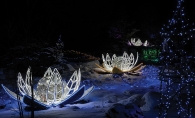Metal casting art studios can be hard to come by, but Minnetonka Center for the Arts has its own little foundry. Creating one of these metal sculptures involves plaster and sand molds, wax sculptures, kilns at 1,000 degrees Fahrenheit and an open-minded, flexible artist. As molten metal forms, hidden inside a plaster mold, it’s very much a gamble.
“It’s a cross between archaeology and Christmas,” says Carey Netherton, MCFTA’s sculpture studio manager and art instructor. “You never know what the outcome will be. It’s also a great way to get out your aggression,” he says, laughing as he cracks open his mold like he’s digging for fossils, eventually revealing a metal cornucopia.
Netherton finds the metal-casting process truly magical, as he compares it to alchemy. Getting in touch with the forces of nature is also a form of meditation. Sometimes a metal sculpture is revealed with details the artist never intended to make, and “sometimes those accidents make it more interesting,” Netherton adds.
Metal casting classes are offered at the Minnetonka Center for the Arts, 2240 North Shore Drive
952.473.7361
ONLINE HED: Minnetonka Center for the Arts Produces Metal Casting Sculptures
The Art of Metal Casting
MCFTA’s Carey Netherton discusses the world of
metal sculptures.
Metal casting art studios can be hard to come by, but Minnetonka Center for the Arts has its own little foundry. Creating one of these metal sculptures involves plaster and sand molds, wax sculptures, kilns at 1,000 degrees Fahrenheit and an open-minded, flexible artist. As molten metal forms, hidden inside a plaster mold, it’s very much a gamble.
“It’s a cross between archaeology and Christmas,” says Carey Netherton, MCFTA’s sculpture studio manager and art instructor. “You never know what the outcome will be. It’s also a great way to get out your aggression,” he says, laughing as he cracks open his mold like he’s digging for fossils, eventually revealing a metal cornucopia.
Netherton finds the metal-casting process truly magical, as he compares it to alchemy. Getting in touch with the forces of nature is also a form of meditation. Sometimes a metal sculpture is revealed with details the artist never intended to make, and “sometimes those accidents make it more interesting,” Netherton adds. —Madie Scott
&
Metal casting classes are offered at the Minnetonka Center for the Arts, 2240 North Shore Drive; 952.473.7361;
minnetonkaarts.org
Photo courtesy of Minnetonka Center for the artsMetal casting art studios can be hard to come by, but Minnetonka Center for the Arts has its own little foundry. Creating one of these metal sculptures involves plaster and sand molds, wax sculptures, kilns at 1,000 degrees Fahrenheit and an open-minded, flexible artist. As molten metal forms, hidden inside a plaster mold, it’s very much a gamble.









